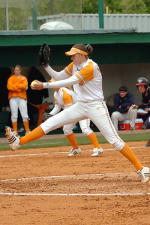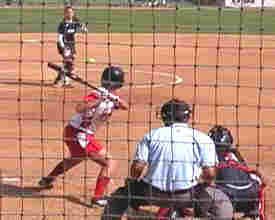|
by Gerald Warner, Softball Pitching
Instructor
 
As mentioned in The
Drop Ball - Part I, we recommend that every serious softball pitcher
develop an effective drop ball.
Whether it is
the "peel/lift-up" style or the "snapover/ rollover"
that is discussed here, a good drop ball adds a
lot to a pitcher's effectiveness.
TO
THROW A DROP BALL, THE PRIMARY OBJECTIVE IS TO GIVE IT MAXIMUM SPIN
There are two basic
ways to throw a drop…the "peel" method (discussed
in "The Drop Ball - Part I") and the "rollover" or "snapover"
(sometimes also called "Over-the-Top") which is
discussed here.
The
"Rollover" (or "Snapover") Drop
Ball
The "rollover" drop is
usually reserved for those pitchers who have physically developed
sufficiently so that their wrist movement can accomplish the rapid
snap "over the top" of the ball at the precise instant it is being
released. Therefore, as a general rule, for younger pitchers
(pre-teenagers), we teach the "peel" method of throwing a drop
ball. For those whose coordination and athleticism
warrant it, we move to the rollover (or "snapover") release.
To Throw a GOOD
Snapover Drop:
1. Grip the
ball on the "narrows"…where the two seams are closest
together. A two-finger grip is best…it lets you have one
finger on each seam...you get a better grip with the fingers on the
stitches of the ball.
2. Take a
shorter stride…6 inches to 15 inches shorter than with your
full speed fastball.
3. Keep your
arm speed slightly slower so you can concentrate on doing
the snapover of the ball precisely at the release. Later, as
you perfect the snapover timing at the release point, you can make
the decision if you want to increase the speed of this
pitch.
4. Land with
weight on your stride leg with the leg as straight as
possible. 
5. Approaching
the release point, keep your wrist bent with the hand back,
and pointing away from your body…and relax your shoulders
6. Stay tall
at the release of the ball…keep your weight forward on the
stride leg; do NOT bend at the waist. It should feel
that you are "on top of the ball." Keep the
elbow close to the body.
7. Precisely
at the release of the ball quickly "snap" your wrist over the top of
the ball to create a fast forward spin
8. A
good snapover creates a low follow-through of your arm (perhaps
lower than the release point). Finish off the
pitch with your little finger (pinky) pointing up, and thumb
pointing down.
For
more experienced pitchers the rollover/snapover method usually
creates a more dramatic drop than the peel release, and although
usually not thrown at full speed, can be a very effective
pitch…sometimes even becoming the pitcher's favorite "go to" pitch
when the need arises.
The article
above can be downloaded and printed from Microsoft Word

If you have questions or need more
information
E-mail us or call Pitching Instructor Gerald Warner in
Colorado at (720) 200-4575
Home Page | | About Us | E-Mail
Us
For 1st & 2nd Year
Pitchers | Beginning
Pitchers | More for Advanced Pitchers | Coaches &
Parents | 










